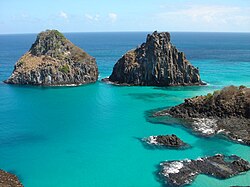Gulf
Appearance
It has been suggested that List of gulfs be merged into this article. (Discuss) Proposed since March 2025. |


A Gulf is a large, deep inlet from the ocean into the landmass, typically larger and more enclosed than a bay, with a narrower opening to the sea.[1][2]
Definition and Formation
[edit]Gulfs form through various geological processes:
- Tectonic plate movements such as rifting or subduction can create vast inlets.[3]
- Erosion and land subsidence also contribute to their formation.
- They are often partially enclosed by peninsulas or islands and may connect to larger oceans via narrow straits.[2][4]
Characteristics
[edit]- Size and Shape
- Hydrodynamics
- Economic and Ecological Importance
Major Gulfs of the World
[edit]| Gulf | Area (km²) | Location | Notes |
|---|---|---|---|
| Gulf of Bengal (Bay of Bengal) | ~2,268,000 | Bay of Bengal | World’s largest “gulf” by area[6] |
| Gulf of Mexico | ~1,567,000 | North America | Encloses U.S., Mexico, Cuba; depth > 4,000 m [5] |
| Hudson Bay | ~820,000 | Canada | Largest gulf in Canada[6] |
| Gulf of Guinea | ~730,000 | West Africa | Deepest gulf (~6,363 m)[8] |
| Gulf of Alaska | ~355,000 | Southern Alaska | Deep fjords and glacial outlets [5] |
| Gulf of Carpentaria | ~328,000 | Northern Australia | Shallow, reef-lined [5] |
| Gulf of Thailand | ~295,000 | Southeast Asia | Warm tropical waters[6] |
| Gulf of Aden | ~278,500 | Between Yemen and Somalia | Major shipping route [5][9] |
| Gulf of Saint Lawrence | ~250,600 | Eastern Canada | Gateway to Great Lakes[1][7][10] |
| Persian Gulf | ~251,000 | West Asia | Major oil region; ecological concerns [4][11] |
Notable Examples
[edit]- Gulf of Mexico: Semi-enclosed basin supporting complex oceanic currents (e.g., Gulf Stream) and massive maritime trade.[5]
- Persian Gulf: Critical for global energy supplies; experiences intense industrialization and ecological stress.[4][11]
- Gulf of Aden: Connects to Red Sea via Bab-el-Mandeb, with ~21,000 ships passing annually.[5][9]
Geographic vs. Terminological Usage
[edit]The boundary between "gulf," "bay," and "sea" is largely conventional:
- A gulf implies greater size/depth and enclosure compared to a bay or bight. [2][5]
- Some small seas (e.g., Sea of Marmara) are technically gulfs.[1]
See also
[edit]References
[edit]- ^ a b c "Gulf | Definition, Characteristics, & Facts | Britannica". www.britannica.com. Retrieved 2025-06-20.
- ^ a b c d e "Gulf". education.nationalgeographic.org. Retrieved 2025-06-20.
- ^ "Plate Tectonics". education.nationalgeographic.org. Retrieved 2025-06-20.
- ^ a b c d e "Definition of GULF". www.merriam-webster.com. 2025-06-15. Retrieved 2025-06-20.
- ^ a b c d e f g h "Major Gulfs of the World". WorldAtlas. 2019-07-02. Retrieved 2025-06-20.
- ^ a b c d e Jiang, Daoyuan; Yang, Qiao; Fang, Yang; Zhang, Xiaoling; Song, Jing (2025-05-12). "A Bibliometric Review of Environmental Pollution Research in Major Global Gulfs". Water. 17 (10): 1455. Bibcode:2025Water..17.1455J. doi:10.3390/w17101455. ISSN 2073-4441.
- ^ a b Ayoob (2024-02-07). "Top 10 Largest Gulfs". Free Source Library. Retrieved 2025-06-20.
- ^ Lahoty, Rajshree (2025-05-19). "Largest Gulfs in the World: An Overview". Leverage Edu. Retrieved 2025-06-20.
- ^ a b "Gulf Of Aden". WorldAtlas. 2021-04-07. Retrieved 2025-06-20.
- ^ "Gulf of St. Lawrence". WorldAtlas. 2023-04-18. Retrieved 2025-06-20.
- ^ a b "Persian Gulf". WorldAtlas. 2021-02-04. Retrieved 2025-06-20.
External links
[edit] Media related to Gulfs at Wikimedia Commons
Media related to Gulfs at Wikimedia Commons


